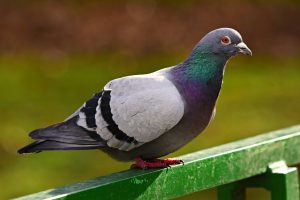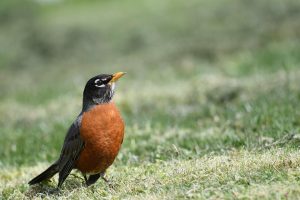About Falcons
6 Prey and Hunting
Lauren Weiss
Peregrine falcons are the fastest animal on earth, reaching dive speeds of 240 miles per hour. (That’s as fast as a car in the Indianapolis 500!)
Their incredible speed is how they hunt. They soar up high over territory and wait for prey to fly by below. With their excellent vision, they can spot prey from 2 miles away.
When prey is spotted, falcons beat their wings to gain speed and drop straight down in a controlled dive called a stoop.

The falcons make a “fist” with their talons and strike their prey hard enough to kill it. They then streak right past it and pull out of their dive to catch it and carry it back. If the strike was not enough to kill it, the falcons use the “tomial teeth” on their beaks.
The male falcon does the majority of the hunting during nesting season. He brings back prey for the incubating female, who will either consume it immediately or cache (store) it for later.
They may perform a mid-air prey exchange, where the female flies underneath the prey-carrying male, turns upside down, and grabs the prey from him with her talons. These exchanges happen very quickly, and only take about 1 second.
When the chicks are young, their parents will tear off small pieces of the prey and feed them. As the chicks get older, they will begin to grab the prey from the adults and take care of that themselves. Once the chicks get to be juveniles, they will literally chase their parents out of the nest box, screaming for them to bring them more prey. After they fledge, they continue to chase their parents, except now in flight, and the parents begin doing mid-air prey exchanges with them to teach them to catch prey and hunt for themselves.
Prey
Peregrine falcons mainly eat other birds. This helps regulate bird populations so the ecosystem is balanced. Over 2,000 species worldwide have been identified as prey for falcons. In general, they typically eat shorebirds, ducks, grebes, gulls, pigeons, and songbirds.
Pigeon Poop
Speaking of pigeons, let’s talk about pigeon poop! Birds cannot produce urine, or pee. Instead, they produce uric acid, which is a white paste-like substance that is made up of nitrogenous wastes. Since it doesn’t dissolve easily in water, it sticks to everything from buildings to car windshields. That’s a problem because uric acid is corrosive, which means the chemicals in it can damage cars’ paint jobs, causing them to rust quicker, as well as make bridges and other structures deteriorate faster. That’s why peregrine falcons tend to be welcomed (and even introduced) into urban settings! By controlling the pigeon population, they help keep the cities’ structures from being damaged by the chemicals in pigeon poop.
(By the way, a scientific study done in England discovered that the colors of cars most likely to be pooped on by birds are red, blue, and black; green is the least likely.)
Local Information: Massachusetts
In Massachusetts, the most common types of prey for peregrine falcons are blue jays, European starlings, and rock doves (pigeons). Other common prey species include red-winged blackbirds, common grackles, American robins, mourning doves, common flickers, chimney swifts, house finches, cedar waxwings, woodcocks, and both black-billed and yellow-billed cuckoos.
 |
 |
 |
 |
 |
 |
 |
 |
 |
 |
 |
 |
 |
 |
With regard to the above part about pigeons, in 2019, Massachusetts taxpayers were actually encouraged to support peregrine falcons on their tax forms to help the state combat pigeon poop!
Digestion
Peregrine falcon chicks start off by eating small meals frequently throughout the day. As they age, they will eat fewer meals per day, but the meals will be longer. Falcons also don’t drink much, since they get almost all their water from their food.
When birds swallow food, it takes a pit stop at an organ called the crop before heading to the stomach. The crop aids in breaking down and storing food for digestion.

Falcons also don’t have teeth; instead, they use gastroliths, more commonly called “gizzard stones.” These are small pieces of gravel/rocks/sand that birds eat and store in their gizzard. Stones held within the gizzard break down the food the birds eat before it gets to the stomach.
When the parents are feeding young chicks, they make sure that they are only feeding them small pieces of meat. However, as they get older, they may also ingest materials like bones and feathers. That’s why falcons cast pellets. Pellets are collections of indigestible material gathered in the stomach of birds that occasionally need to be disposed of. Once they are old enough, falcons will regurgitate them regularly every 1-2 days to keep their digestive tract clean.
Media Attributions
- Stoop_296949265_1534167763705099_3009853800788518790_n © Michael Pociecha is licensed under a CC BY-SA (Attribution ShareAlike) license
- prey_bird-g39f550962_1280 Blue Jay © Pixabay is licensed under a CC0 (Creative Commons Zero) license
- prey_birds-gfa45ce8a9_1920 Starling © Pixabay is licensed under a CC0 (Creative Commons Zero) license
- Prey_rock-dove-g00b235c4a_1920 © Pixabay is licensed under a CC0 (Creative Commons Zero) license
- Red Winged Blackbird © Pixabay is licensed under a CC0 (Creative Commons Zero) license
- prey_common-grackle-g0ee001011_1920 © Pixabay is licensed under a CC0 (Creative Commons Zero) license
- prey_american-robin-g89bfe1931_1920 © Pixabay is licensed under a CC0 (Creative Commons Zero) license
- Mourning Dove © Pixabay is licensed under a CC0 (Creative Commons Zero) license
- Red Flicker © Pixabay is licensed under a CC0 (Creative Commons Zero) license
- Chimney Swift © Pixabay is licensed under a CC0 (Creative Commons Zero) license
- House Finch © Pixabay is licensed under a CC0 (Creative Commons Zero) license
- Cedar Waxwing © Pixabay is licensed under a CC0 (Creative Commons Zero) license
- Woodcock © Pixabay is licensed under a CC0 (Creative Commons Zero) license
- Black Billed Cuckoo © Pixabay is licensed under a CC0 (Creative Commons Zero) license
- Yellow Billed Cuckoo © Pixabay is licensed under a CC0 (Creative Commons Zero) license
- Digestion_Full Crops © UMass Amherst Libraries is licensed under a CC BY (Attribution) license

